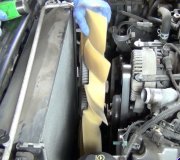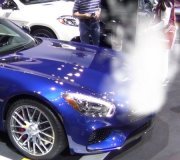Welcome back:
If it makes a lot of noise regardless of temperature and being disconnected or connected, it sounds like the clutch has failed and is staying engaged.
Here are a few links that you may find of interest. Take a look through them.
https://www.2carpros.com/articles/how-a-clutch-fan-works
https://www.2carpros.com/articles/fan-clutch-symptoms
https://www.2carpros.com/articles/fan-clutch-removal
If you determine that it is bad, here are the directions for replacement specific to your vehicle. The worst part is removing the fan shroud to get to it. All pics correlate with the directions,
++++++++++++++++++++++++++++++++++++++++++++++++++
COOLING FAN AND SHROUD REPLACEMENT
Cooling Fan and Shroud Replacement
- Tools Required
- J 38185 Hose Clamp Pliers
- J 46406 Fan Clutch Remover and Installer
Removal Procedure
pic 1
1. Remove the hood latch support.
2. Disconnect the transmission cooler lines at the engine and release the lines from the fan shroud.
3. Remove the 2 upper bolts on the fan shroud.
4. Drain the cooling system.
5. Reposition the upper inlet radiator hose clamp using J38185.
6. Remove the upper inlet radiator hose from the radiator.
7. Remove the electrical connector from the shroud.
pic 2
8. Position the water pump so the bolts are aligned in the vertical.
9. Remove the fan hub nut from the water pump shaft in a counterclockwise rotation. Using the J 46406, in order to secure the water pump pulley, loosen the cooling fan hub nut from the water pump shaft.
pic 3
10. Unclip the fan shroud from the radiator at the side panels (1).
11. Tilt the radiator and the condenser forward.
12. Lift the fan and the shroud up and out towards the engine to release the fan from the radiator to clear the radiator inlet.
Installation Procedure
pic 4
1. Install the fan and the shroud onto the lip of the radiator bottom.
Notice: Refer to Fastener Notice in Service Precautions.
2. Install the 2 bolts into the upper fan shroud and tighten.
Tighten the bolts to 28 Nm (21 ft. lbs.).
3. Connect the electrical connector.
4. Clip the fan shroud to the radiator at the side panels (1).
pic 5
5. Using the J 46406 to secure the water pump pulley, install the fan nut to the water pump shaft in a clockwise rotation.
Tighten the fan hub nut to 56 Nm (41 ft. lbs.).
pic 6
6. Install the transmission cooler lines to the engine and clip into the fan shroud.
7. Install the hood latch support.
8. Install the upper inlet radiator hose to the radiator.
9. Reposition the upper inlet radiator hose clamp using J 38185.
10. Fill the cooling system.
__________________________________________________________
PROCEDURES
Fan Clutch Replacement
Removal Procedure
1. Remove the cooling fan and shroud. See: Fan Shroud > Procedures > Cooling Fan and Shroud Replacement
pic 7
2. Remove the fan clutch from the fan shroud.
3. Remove the bolts retaining the fan blade to the fan clutch.
4. Separate the fan blade from the fan clutch.
Installation Procedure
1. Assemble the fan blade to the fan clutch.
Notice: Use the correct fastener in the correct location. Replacement fasteners must be the correct part number for that application. Fasteners requiring replacement or fasteners requiring the use of thread locking compound or sealant are identified in the service procedure. Do not use paints, lubricants, or corrosion inhibitors on fasteners or fastener joint surfaces unless specified. These coatings affect fastener torque and joint clamping force and may damage the fastener. Use the correct tightening sequence and specifications when installing fasteners in order to avoid damage to parts and systems.
2. Install the 4 bolts to the fan blade. Tighten the bolts to 27 Nm (20 lb ft).
3. Install the fan clutch to the fan shroud.
4. Install the cooling fan and shroud. See: Fan Shroud > Procedures > Cooling Fan and Shroud Replacement
_________________________________
Let me know if this helps or if you have other questions.
Take care,
Joe
Images (Click to make bigger)
Monday, July 1st, 2019 AT 9:09 PM












